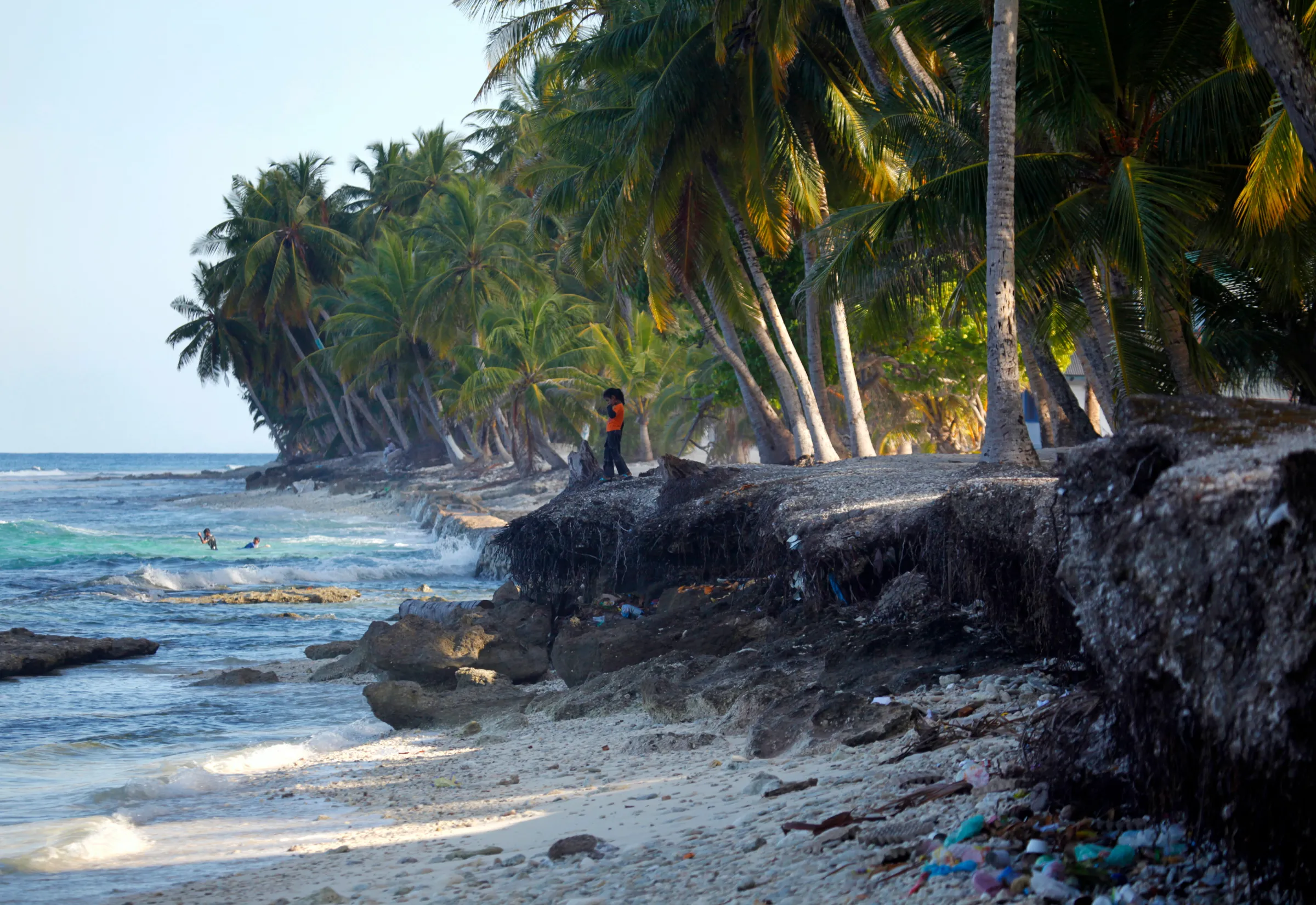The world’s smallest states must find new tools, new alliances, and new ways to turn vulnerability into resilience.
How to defuse the climate-debt time bomb for small island states

A girl walks at a beach damaged by erosion at Fuvahmulah December 9, 2009. REUTERS/Reinhard Krause
We need innovative solutions to allow small island nations to manage debt and build climate resilience as global funding declines.
Emily Wilkinson is a principal research fellow at ODI Global and director of the Resilient and Sustainable Islands Initiative (RESI) and Ambassador Ali Naseer Mohamed is the Permanent Representative of the Maldives to the U.N. and former Chair of the Alliance of Small Island States.
With climate finance and foreign aid shrinking and debt continuing to rise, small island states are being forced to rethink how they survive, not just how they grow.
Yet the climate threats keep coming louder, faster, and more destructive. In this storm, innovation is not optional. The world’s smallest states must find new tools, new alliances, and new ways to turn vulnerability into resilience.
Debt is already causing unacceptable delays to efforts to build climate resilience for the world’s 39 small island developing states, with debt repayments eroding vital foreign reserves and limiting expenditure on critical projects and public services.
These states, including the Maldives, Bahamas and Fiji, are uniquely vulnerable to a warming world and heavily dependent on external assistance and a financial system which penalises smaller players.
Debt burden
Last year, the ODI Global think tank assessed rising debt in these islands and found that interest payments were eroding crucial public spending on healthcare and education.
Debt also means these countries are not able to build more resilient systems to help them cope with ever more extreme weather, rising seas and changes to coastlines and habitats.
A new briefing paper shows that between 2026 and 2028, these small island nations are projected to pay over $27 billion in debt service to external creditors, with $12 billion going to official creditors and $15.3 billion to private creditors, according to World Bank statistics.
The Maldives and Suriname currently borrow on international bond markets at a staggering 12% - this compares to 3.09% for G7 countries.
As a result, external debt service payments overall in small island states have grown several times faster than their spending on education, health and capital investment between 2020–2022, compared with 2010–2012, and this trend is expected to continue.
Hunt for new solutions
New solutions are needed and the World Bank, along with International Monetary Fund, which are meeting in Washington this week, have a key role to play.
The World Bank and regional development banks need to step in and help lower borrowing costs by, for example, providing credit guarantees and more concessional finance and, by scaling up offers of debt swaps to make debt cheaper like the recent debt for nature swap in Barbados, more climate resilient infrastructure can be built.
Fresh ideas are emerging: The Maldives is designing an innovative debt-for-resilience-building mechanism that links debt relief directly to progress on climate resilience.
Under this mechanism, countries can secure debt forgiveness or interest reduction by meeting pre-agreed milestones in resilience-building investments.
For example, if a country invests $150 million to build its renewable energy infrastructure, creditors would forgive a portion of its debt or reduce interest rates.
This innovative approach allows highly indebted countries to build climate defences while easing debt burdens.
This is not just smart policy; it’s a lifeline for countries trapped between climate disaster and fiscal collapse.
Most crucially, there would be no new debt for the debtor countries.
This is not just smart policy; it’s a lifeline for countries trapped between climate disaster and fiscal collapse.
These kinds of innovations buy time and space. They allow governments to redirect funds from debt service to public investment in people, infrastructure, and recovery. But innovations alone won’t solve the crisis.
Small island nations crucially need to create their own, home-grown solutions and use finance more effectively for development, based on quality data and statistics.
This is exactly what the Antigua and Barbuda Agenda for Small Island Developing States (ABAS), adopted in 2024, calls for: more finance, but also capacity support so they can use it wisely, fairly, and for long-term resilience.
The World Bank, as an important source of knowledge and policy advice on financing for development, must lead; it should help these nations build state capacity and design effective financing mechanisms.
If we wait for these countries to sink under their debt, we miss the chance to protect our shared future.
Any views expressed in this opinion piece are those of the author and not of Context or the Thomson Reuters Foundation.
Tags
- Adaptation
- Climate inequality
- Loss and damage
Go Deeper
Related
Latest on Context
- 1
- 2
- 3
- 4
- 5
- 6
Most Read
- 1
- 2
- 3
- 4
- 5

















